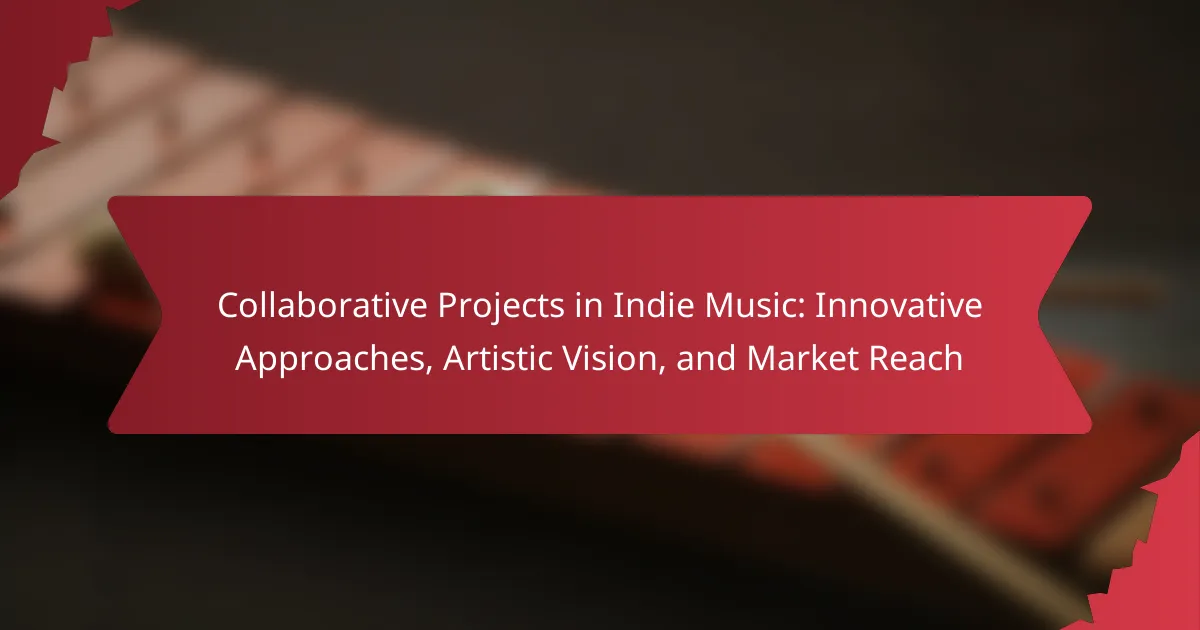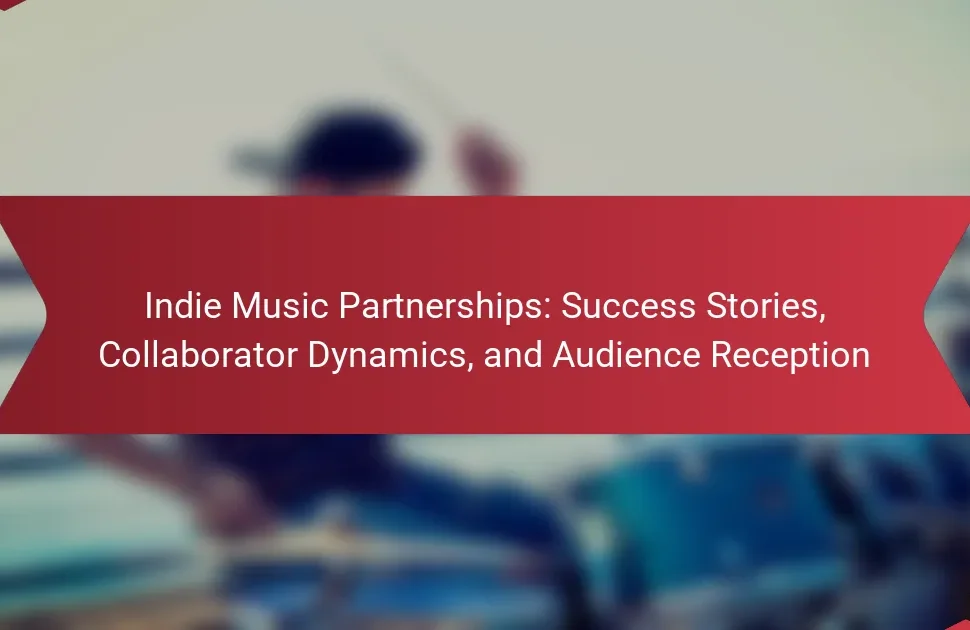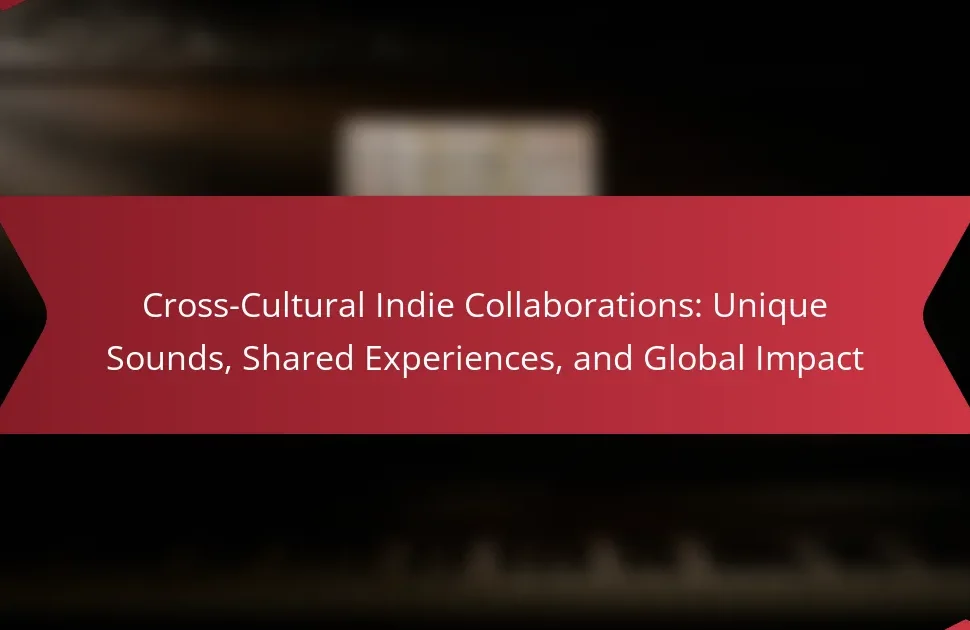Collaborative projects in indie music offer artists innovative approaches to enhance creativity and broaden market reach. These initiatives involve multiple artists sharing their unique styles, leading to distinctive soundscapes and artistic visions. They also provide opportunities for cross-promotion, tapping into diverse fan bases and expanding visibility. However, challenges such as creative differences and resource limitations can impact the success of these collaborations.
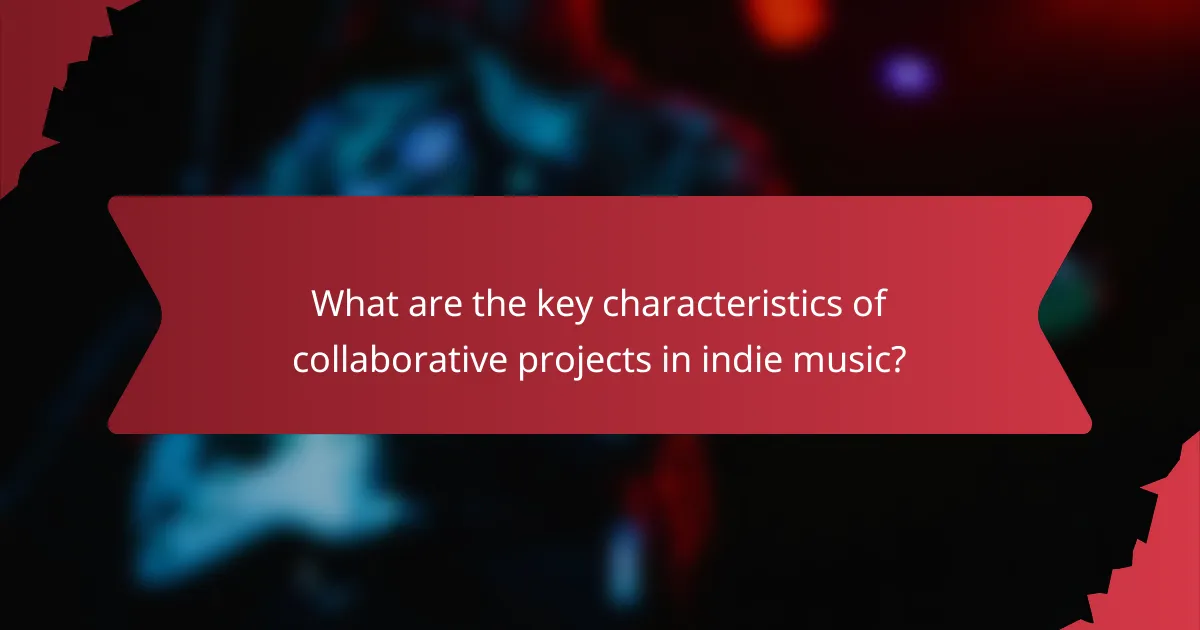
What are the key characteristics of collaborative projects in indie music?
Collaborative projects in indie music are characterized by innovation, artistic vision, and diverse market reach. These projects often involve multiple artists combining their unique styles, which enhances creativity and broadens audience appeal.
One key aspect is the shared artistic vision, allowing artists to explore new genres and concepts together. Collaborative efforts often lead to unique soundscapes that distinguish them from solo projects. Additionally, the pooling of resources and networks expands market reach, facilitating access to wider audiences.
Collaboration can also bring together artists with rare attributes, such as distinct cultural backgrounds or unconventional styles, creating unique musical experiences. As a result, these projects can foster a sense of community among indie musicians, encouraging experimentation and growth within the genre.
How do artistic visions shape collaborative efforts?
Artistic visions are crucial in shaping collaborative efforts in indie music. They inspire creativity, unify diverse talents, and enhance market appeal. A shared artistic vision fosters innovation, leading to unique soundscapes and engaging narratives. This collaboration can expand market reach by attracting varied audiences, as artists blend their distinct styles and perspectives. Ultimately, a strong artistic vision drives successful partnerships, resulting in memorable and impactful projects.
Which innovative approaches are emerging in the indie music scene?
Collaborative projects are reshaping the indie music scene through innovative approaches that enhance artistic vision and market reach. Artists are increasingly forming partnerships to create unique sounds and diversify their audiences.
One emerging trend is the use of digital platforms for collaboration, allowing musicians from different locations to work together seamlessly. This approach not only expands creative possibilities but also increases visibility across various markets.
Another notable method is the incorporation of multimedia elements, such as visual art and interactive experiences, into music projects. This strategy engages audiences on multiple levels, fostering deeper connections with the music.
Crowdfunding is also gaining traction, empowering artists to finance their projects directly through fan support. This model not only democratizes funding but also builds a loyal community around the music.
What role does technology play in facilitating collaboration?
Technology plays a crucial role in enhancing collaboration in indie music projects. It enables artists to connect globally, share resources, and co-create in real-time. Digital platforms facilitate communication and project management, allowing for innovative approaches to artistic vision. Collaborative tools like cloud storage and virtual studios expand market reach by making music production accessible and efficient. These technologies foster creativity and streamline the workflow, ultimately leading to successful collaborations that resonate with diverse audiences.
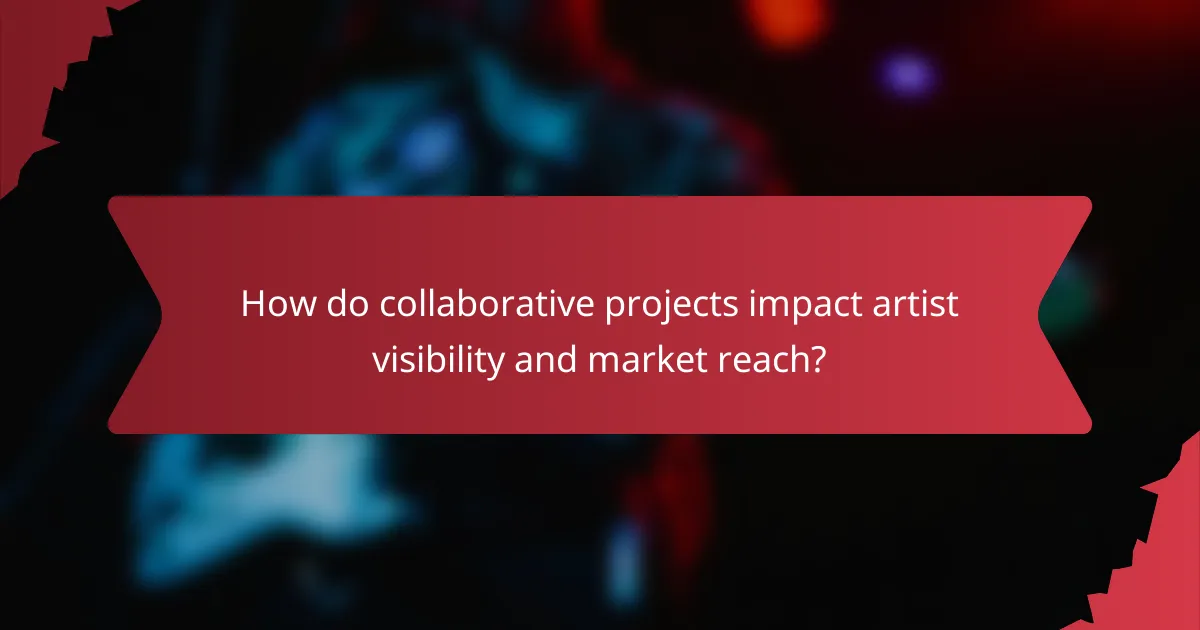
How do collaborative projects impact artist visibility and market reach?
Collaborative projects significantly enhance artist visibility and market reach. These partnerships allow artists to tap into each other’s fan bases, creating cross-promotional opportunities. For instance, joint performances or shared tracks can introduce artists to new audiences, increasing their overall exposure.
Moreover, collaborations often lead to innovative soundscapes that attract diverse listeners, enhancing marketability. Unique artistic visions displayed through collaborations can also garner media attention, further amplifying visibility. As a result, artists can achieve greater success in a competitive industry.
What strategies enhance audience engagement in collaborative music projects?
Collaborative music projects enhance audience engagement through interactive experiences, social media integration, and community involvement. These strategies foster a sense of belonging and connection among fans.
Interactive experiences, such as live-streamed jam sessions or virtual songwriting workshops, invite audience participation. Social media integration allows artists to share behind-the-scenes content, making fans feel more connected to the creative process. Community involvement, through local events or charity collaborations, strengthens ties and encourages fan loyalty.
By implementing these strategies, indie music projects can effectively broaden their market reach and cultivate a dedicated fan base.
How do collaborations influence streaming and sales metrics?
Collaborations significantly enhance streaming and sales metrics in indie music by broadening audience reach and increasing engagement. Joint projects often combine unique artistic visions, attracting diverse fan bases. This synergy can lead to higher streaming numbers and boosted sales figures. For instance, a collaboration can introduce an artist to a collaborator’s established audience, creating cross-promotional opportunities. As a result, metrics such as monthly listeners and track sales often see substantial growth post-collaboration.
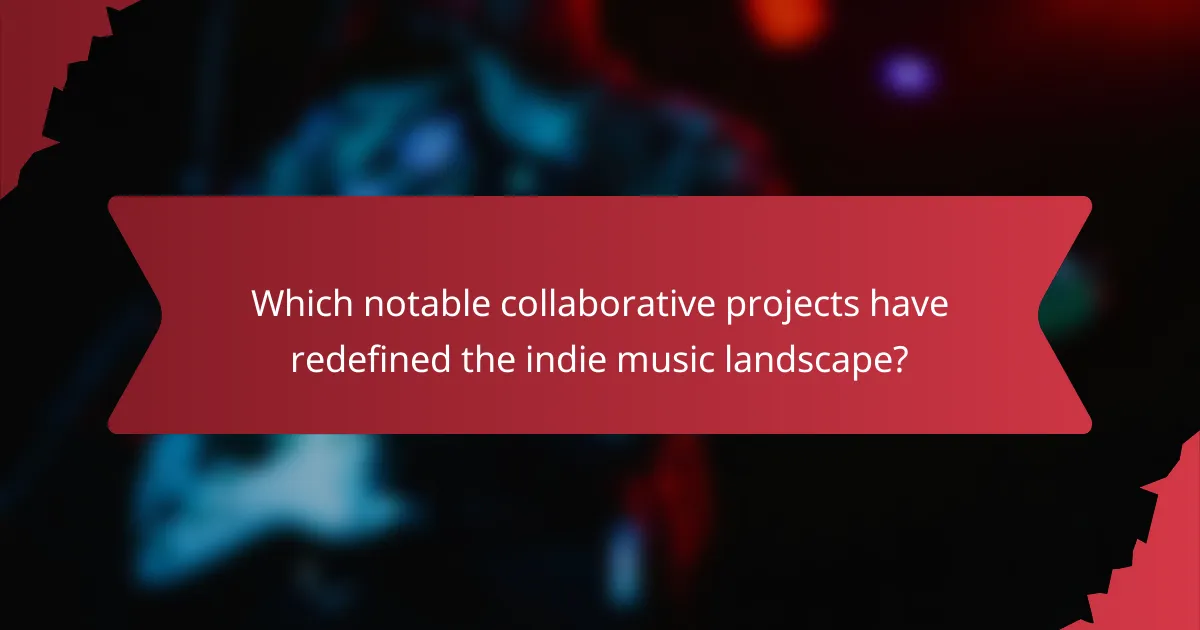
Which notable collaborative projects have redefined the indie music landscape?
Notable collaborative projects have significantly influenced the indie music landscape by blending diverse artistic visions. Projects like “The Postal Service” and “Sufjan Stevens’ 50 States Project” showcase innovative approaches that expand market reach. These collaborations often combine unique styles, drawing in wider audiences and redefining genre boundaries. The synergy between artists fosters creativity and experimentation, leading to fresh sounds that resonate with fans.
What unique attributes set successful collaborations apart?
Successful collaborations in indie music stand out due to their unique artistic vision and innovative approaches. These projects often feature diverse influences, allowing for fresh sounds that resonate with audiences. Strong communication among artists fosters creativity and enhances the project’s market reach. Additionally, collaborations that leverage social media effectively can amplify visibility and engagement, setting them apart in a competitive landscape. Unique attributes like genre-blending and cross-disciplinary partnerships further distinguish successful indie music collaborations.
How do cultural influences shape collaborative music initiatives?
Cultural influences significantly shape collaborative music initiatives by fostering diverse artistic expressions and broadening market reach. These initiatives often blend various musical styles, reflecting the unique cultural backgrounds of the artists involved. For instance, collaborations between musicians from different countries can create innovative sounds that resonate with wider audiences.
Additionally, cultural contexts inform the themes and messages conveyed in music, enhancing its relevance and emotional impact. As a result, collaborative projects often address social issues or celebrate cultural heritage, attracting listeners who identify with those narratives. This cultural synergy not only enriches the music but also expands its appeal across different demographics, driving greater market engagement.
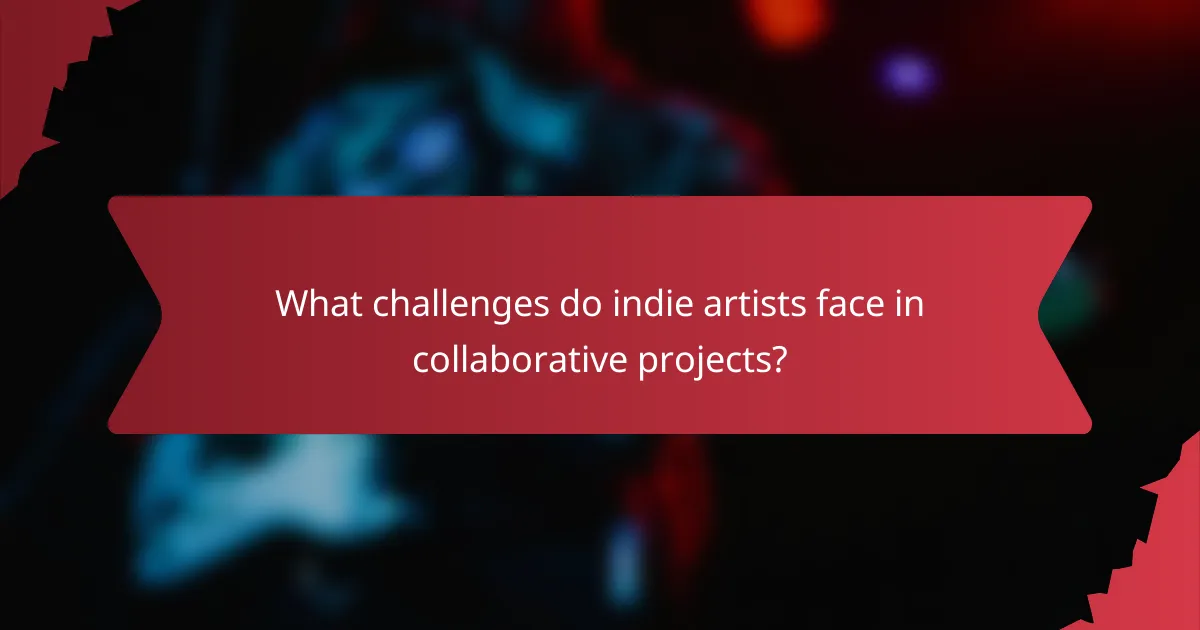
What challenges do indie artists face in collaborative projects?
Indie artists face several challenges in collaborative projects, including creative differences, resource limitations, and market visibility. Creative differences can hinder artistic vision and lead to conflicts. Resource limitations, such as funding and access to professional networks, restrict project scope. Additionally, indie artists often struggle to achieve market reach due to competition and lack of promotional support. These factors collectively impact the success of collaborative efforts in the indie music scene.
How can artists navigate creative differences in collaborations?
Artists can navigate creative differences in collaborations by fostering open communication and mutual respect. Establishing clear goals early on helps align artistic visions. Regular check-ins can address any emerging conflicts. Emphasizing compromise allows for a blending of ideas, enhancing the final output. Lastly, celebrating each member’s unique contributions fosters a positive collaborative environment.
What are common pitfalls to avoid in collaborative music projects?
Common pitfalls in collaborative music projects include lack of clear communication, differing artistic visions, and inadequate conflict resolution strategies. These issues can derail creativity and hinder project progress. Establishing defined roles and responsibilities helps mitigate confusion. Regular check-ins foster open dialogue, ensuring all contributors are aligned. Emphasizing shared goals enhances collaborative synergy, ultimately leading to a more successful outcome.
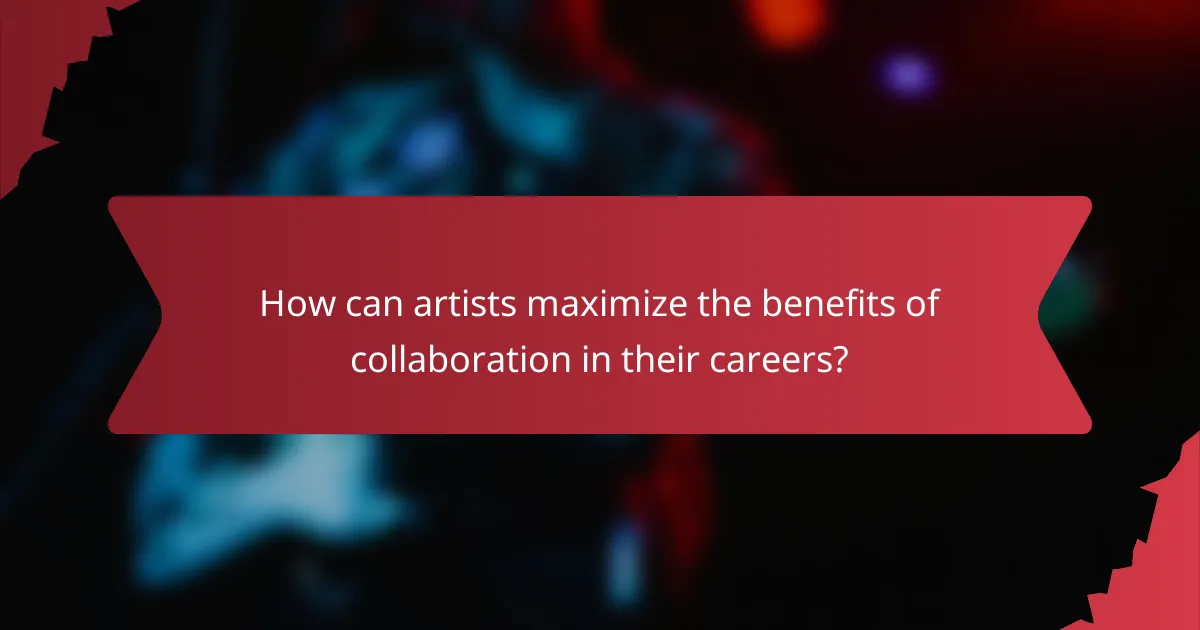
How can artists maximize the benefits of collaboration in their careers?
Artists can maximize collaboration benefits by leveraging diverse skills, expanding their audience, and fostering innovation. Collaborative projects enhance creative expression and market reach, allowing artists to experiment and gain exposure.
Working with others introduces new artistic visions and influences, enriching the overall sound and style. Collaborations can also provide access to different fan bases, increasing visibility and potential sales. As a result, artists can cultivate a more robust career through strategic partnerships.
Additionally, collaborations can lead to unique projects that stand out in the indie music scene. For example, merging genres or incorporating multimedia elements can attract attention and drive engagement. This innovative approach often results in memorable experiences for audiences, further solidifying an artist’s reputation.
In summary, artists should seek collaborations to diversify their work, enhance creativity, and expand their market reach. This strategy not only boosts their artistic vision but also solidifies their presence in the competitive indie music landscape.
What best practices should indie musicians follow for successful collaborations?
Indie musicians should prioritize clear communication, mutual respect, and shared goals for successful collaborations. Establishing a cohesive artistic vision is essential.
1. Define roles and responsibilities early to avoid confusion.
2. Foster open dialogue to encourage creativity and innovation.
3. Set realistic timelines to maintain momentum.
4. Leverage each collaborator’s strengths to enhance the project.
5. Promote the collaboration through social media and events to maximize market reach.
These practices help build a strong foundation, ensuring a productive and rewarding collaborative experience.
How can effective communication enhance collaborative outcomes?
Effective communication significantly enhances collaborative outcomes by fostering trust and clarity. It enables artists in indie music to share their innovative ideas and artistic visions effectively. Clear dialogue reduces misunderstandings, ensuring that all collaborators are aligned on project goals. This alignment increases market reach by creating a cohesive brand message that resonates with audiences. Moreover, effective communication encourages feedback, allowing for continuous improvement and adaptation in collaborative projects.
What resources are available to support collaborative projects in indie music?
Collaborative projects in indie music benefit from various resources that enhance creativity and distribution. Key resources include community platforms, funding options, and collaboration tools.
1. Community platforms like Bandcamp and SoundCloud connect artists for collaboration and audience engagement.
2. Crowdfunding sites such as Kickstarter and Patreon provide financial support for projects, allowing artists to realize their visions.
3. Collaboration tools like Splice and Soundtrap facilitate remote music creation, enabling artists to work together seamlessly.
4. Workshops and music festivals offer networking opportunities and skill development, fostering artistic growth and collaboration.
5. Social media channels enable artists to promote their collaborative efforts and reach wider audiences effectively.
